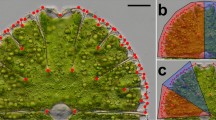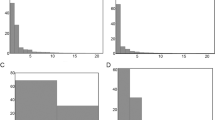Abstract
Calcifying green algae of the genus Halimeda J.V. Lamouroux are typical for the modular thalli composed of serial segments. Their CaCO3 content gradually increases with age due to calcification, the intensity of which is largely linked to photosynthesis. The dynamics of segment phenotypic plasticity at different scales and its relation to CaCO3 content is not well known. We investigated the populations of Halimeda tuna in the upper sublittoral of four regions on the Adriatic Sea coast. Using geometric morphometrics, we explored the patterns of segment shape plasticity, their relationships with the spatial factors and CaCO3 content. The results showed that segment position on thalli was the main determinant of their shape features. This effect was considerably more prominent than the differences among plants, populations, or regions. Likewise, the segment shape proved to be a significant predictor of their CaCO3 content. Segments with inversely conical shapes, typical for the lower parts of branches, contained significantly less CaCO3 than the reniform and oval segments that probably contribute most to the overall carbonate budget of the Mediterranean Halimeda draperies.




Similar content being viewed by others
Data availability
Primary data used for the analyses are available online at: http://doi.org/10.5281/zenodo.5504135
Code availability
The R scripts used for the analyses are available online at: http://doi.org/10.5281/zenodo.5504135
References
Adams, D. C. & E. Otárola-Castillo, 2013. geomorph: an R package for the collection and analysis of geometric morphometric shape data. Methods in Ecology and Evolution 4: 393–399.
Anderson, M. J., 2017. Permutational multivariate analysis of variance (PERMANOVA). In Balakrishnan, N., T. Colton, B. Everitt, W. Piegorsch, F. Ruggeri & J. L. Teugels (eds), Wiley StatsRef: Statistics Reference Online Wile, Oxford: 1–15. https://doi.org/10.1002/9781118445112.stat07841.
Anderson, M. J. & D. C. I. Walsh, 2013. What null hypothesis are you testing? PERMANOVA, ANOSIM and the Mantel test in the face of heterogenous dispersions. Ecological Monographs 83: 557–574.
Ballesteros, E., 1991a. Seasonality of growth and production of a deep-water population of Halimeda tuna (Chlorophyceae, Caulerpales) in the north-western Mediterranean. Botanica Marina 34: 291–301.
Ballesteros, E., 1991b. Structure of a deep-water community of Halimeda tuna (Chlorophyceae, Caulerpales) from the North-Western Mediterranean. Collectanea Botanica 20: 5–21.
Barry, S. C., T. K. Frazer & C. A. Jacoby, 2013. Production and carbonate dynamics of Halimeda incrassata (Ellis) Lamouroux altered by Thalassia testudinum Banks and Soland ex König. Journal of Experimental Marine Biology and Ecology 444: 73–80.
Bilgin, S. & Ö. O. Ertan, 2002. Selected chemical constituents and their seasonal variations in Flabellia petiolata (Turra) Nizam. and Halimeda tuna (Ellis & Sol.) J.V.Lamour. in the Gulf of Antalya (North-eastern Mediterranean). Turkish Journal of Botany 26: 87–90.
Böhm, E. L., 1973. Studies on the mineral content of calcareous algae. Bulletin of Marine Science 23: 177–190.
Bonacci, O., D. Bonacci, M. Patekar & M. Pola, 2021. Increasing trends in air and sea surface temperature in the Central Adriatic Sea (Croatia). Journal of Marine Science and Engineering 9: 1–17.
Borowitzka, M. A. & A. W. D. Larkum, 1976. Calcification in the green alga Halimeda. II. The exchange of Ca2+ and the occurrence of age gradients in calcification and photosynthesis. Journal of Experimental Botany 27: 864–878.
Borowitzka, M. A. & A. W. D. Larkum, 1987. Calcification in algae: mechanisms and the role of metabolism. Critical Reviews in Plant Sciences 6: 1–45.
Canals, M. & E. Ballesteros, 1997. Production of carbonate particles by phytobenthic communities on the Mallorca-Menorca shelf, northwestern Mediterranean Sea. Deep-Sea Research II 44: 611–629.
Cardini, A., K. Seetah & G. Barker, 2015. How many specimens do I need? Sampling error in geometric morphometrics: testing the sensitivity of means and variances in simple randomized selection experiments. Zoomorphology 134: 149–163.
Carneiro, P. B. M., J. U. Pereira & H. Matthews-Cascon, 2018. Standing stock variations, growth and CaCO3 production by the calcareous green alga Halimeda opuntia. Journal of the Marine Biological Association of the United Kingdom 98: 401–409.
Davies, P. J., 2011. Halimeda bioherms. In Hopley, D. (ed), Encyclopedia of Modern Coral Reefs Springer, Dordrecht: 539–549.
Drew, E. A., 1983. Halimeda biomass, growth rates and sediment generation on reefs in the Central Great Barrier Reef Province. Coral Reefs 2: 101–110.
Gunz, P. & P. Mitteroecker, 2013. Semilandmarks: a method for quantifying curves and surfaces. Hystrix Italian Journal of Mammalogy 24: 103–109.
Habel, K., R. Grasman, R. B. Gramacy, P. Mozharovskyi & D. C. Sterratt, 2019. geometry: mesh generation and surface tessellation. R package version 0.4.5. https://CRAN.R-project.org/package=geometry
Hall-Spencer, J. M. & B. P. Harvey, 2019. Ocean acidification impacts on coastal ecosystem services due to habitat degradation. Emerging Topics in Life Sciences 3: 197–206.
Hammer, Ø., D. A. T. Harper & P. D. Ryan, 2001. PAST: paleontological statistics software package for education and data analysis. Palaeontologia Electronica 4: 1–9.
Hillis, L., 1991. Recent calcified Halimedaceae. In Riding, R. (ed), Calcareous Algae and Stromatolites Springer, Heidelberg: 167–188.
Hillis-Colinvaux, L., 1980. Ecology and Taxonomy of Halimeda: Primary Producer of Coral Reefs, Academic Press, London:
Jensen, P. R., R. A. Gibson, M. M. Littler & D. S. Littler, 1985. Photosynthesis and calcification in four deep-water Halimeda species (Chlorophyceae, Caulerpales). Deep-Sea Research 32: 451–464.
Klingenberg, C. P., M. Barluenga & A. Meyer, 2002. Shape analysis of symmetric structures: quantifying variation among individuals and asymmetry. Evolution 56: 1909–1920.
Kooistra, W. H. C. F. & H. Verbruggen, 2005. Genetic patterns in the calcified tropical seaweeds Halimeda opuntia, H. distorta, H. hederacea, and H. minima (Bryopsidales, Chlorophyta) provide insights in species boundaries and interoceanic dispersal. Journal of Phycology 41: 177–187.
Llobet, I., J. M. Gili & R. G. Hughes, 1991. Horizontal, vertical and seasonal distributions of epiphytic hydrozoa on the alga Halimeda tuna in the Northwestern Mediterranean Sea. Marine Biology 110: 151–159.
McNicholl, C., M. S. Koch & L. C. Hofmann, 2019. Photosynthesis and light-dependent proton pumps increase boundary layer pH in tropical macroalgae: a proposed mechanism to sustain calcification under ocean acidification. Journal of Experimental Marine Biology and Ecology 521: 151208.
Mucci, A., 1983. The solubility of calcite and aragonite in seawater at various salinities, temperatures, and one atmosphere total pressure. American Journal of Science 283: 780–799.
Neustupa, J. & Y. Nemcova, 2018. Morphological allometry constrains symmetric shape variation, but not asymmetry, of Halimeda tuna (Bryopsidales, Ulvophyceae) segments. PLoS ONE 13: e0206492.
Neustupa, J. & Y. Nemcova, 2020. Morphometric analysis of surface utricles in Halimeda tuna (Bryopsidales, Ulvophyceae) reveals variation in their size and symmetry within individual segments. Symmetry 12: 1271.
Ortegón-Aznar, I., A. Chuc-Contreras & L. Collado-Vides, 2017. Calcareous green algae standing stock in a tropical sedimentary coast. Journal of Applied Phycology 29: 2685–2693.
Pastor, F., J. A. Valiente & J. L. Palau, 2018. Sea surface temperature in the Mediterranean: trends and spatial patterns (1982–2016). Pure and Applied Geophysics 175: 4017–4029.
Peach, K. E., M. S. Koch, P. L. Blackwelder, D. Guerrero-Given & N. Kamasawa, 2017. Primary utricle structure of six Halimeda species and potential relevance for ocean acidification tolerance. Botanica Marina 60: 1–11.
Perez, S. I., V. Bernal & P. N. Gonzalez, 2006. Differences between sliding semilandmark methods in geometric morphometrics, with an application to human craniofacial and dental variation. Journal of Anatomy 208: 769–784.
Perrett, J. J. & D. J. Mundfrom, 2010. Bonferroni procedure. In Salkind, N. J. (ed), Encyclopedia of Research Design Sage Publ, Thousand Oaks, CA: 98–101.
Pongparadon, S., G. C. Zuccarello & A. Prathep, 2017. High morpho-anatomical variability in Halimeda macroloba (Bryopsidales, Chlorophyta) in Thai waters. Phycological Research 65: 136–145.
Pongparadon, S., S. Nooek & A. Prathep, 2020. Phenotypic plasticity and morphological adaptation of Halimeda opuntia (Bryopsidales, Chlorophyta) to light intensity. Phycological Research 68: 115–125.
Prathep, A., R. Kaewsrikhaw, J. Mayakun & A. Darakrai, 2018. The effects of light intensity and temperature on the calcification rate of Halimeda macroloba. Journal of Applied Phycology 30: 3405–3412.
Prát, S. & J. Hamáčková, 1946. The analysis of calcareous marine algae. Studia Botanica Čechoslovaca 7: 112–126.
R Core Team, 2020. A Language and Environment for Statistical Computing, R Foundation for Statistical Computing, Vienna:
Rees, S. A., B. N. Opdyke, P. A. Wilson & T. J. Henstock, 2007. Significance of Halimeda bioherms to the global carbonate budget based on a geological sediment budget for the Northern Great Barrier Reef, Australia. Coral Reefs 26: 177–188.
Rindi, F., M. M. Pasella, M. F. E. Lee & H. Verbruggen, 2020. Phylogeography of the mediterranean green seaweed Halimeda tuna (Ulvophyceae, Chlorophyta). Journal of Phycology 56: 1109–1113.
Rohlf, F. J., 2015. The tps series of software. Hystrix Italian Journal of Mammalogy 26: 9–12.
Schaefer, K., T. Lauc, P. Mitteroecker, P. Gunz & F. L. Bookstein, 2006. Dental arch asymmetry in an isolated Adriatic community. American Journal of Physical Anthropology 129: 132–142.
Smith, J. E., C. M. Smith, P. S. Vroom, K. L. Beach & S. Miller, 2004. Nutrient and growth dynamics of Halimeda tuna on Conch Reef, Florida Keys: possible influence of internal tides on nutrient status and physiology. Limnology and Oceanography 49: 1923–1936.
Stark, L. M., L. Almodovar & R. W. Krauss, 1969. Factors affecting the rate of calcification in Halimeda opuntia (L.) Lamouroux and Halimeda discoidea Decaisne. Journal of Phycology 5: 305–312.
van Tussenbroek, B. I. & J. K. van Dijk, 2007. Spatial and temporal variability in biomass and production of psammophytic Halimeda incrassata (Bryopsidales, Chlorophyta) in a Caribbean reef lagoon. Journal of Phycology 43: 69–77.
Verbruggen, H., O. De Clerck & E. Coppejans, 2005. Deviant segments hamper a morphometric approach towards Halimeda taxonomy. Cryptogamie Algologie 26: 259–274.
Verbruggen, H., O. De Clerck, A. D. R. N’yeurt, H. Spalding & P. S. Vroom, 2006. Phylogeny and taxonomy of Halimeda incrassata, including descriptions of H. kanaloana and H. heteromorpha spp. nov. (Bryopsidales, Chlorophyta). European Journal of Phycology 41: 337–362.
Vergés, A., P. D. Steinberg, M. E. Hay, A. G. B. Poore, A. H. Campbell, E. Ballesteros, K. L. Heck Jr., D. J. Booth, M. A. Coleman, D. A. Feary, W. Figueira, T. Langlois, E. M. Marzinelli, T. Mizerek, P. J. Mumby, Y. Nakamura, M. Roughan, E. Van Sebille, A. S. Gupta, D. A. Smale, F. Tomas, T. Wernberg & S. K. Wilson, 2014. The tropicalization of temperate marine ecosystems: climate-mediated changes in herbivory and community phase shifts. Proceedings of the Royal Society B 281: 20140846.
Vroom, P. S., C. M. Smith, J. A. Coyer, L. J. Walters, C. L. Hunter, K. S. Beach & J. E. Smith, 2003. Field biology of Halimeda tuna (Bryopsidales, Chlorophyta) across a depth gradient: comparative growth, survivorship, recruitment, and reproduction. Hydrobiologia 501: 149–166.
Wizemann, A., F. W. Meyer & H. Westphal, 2014. A new model for the calcification of the green macro-alga Halimeda opuntia (Lamouroux). Coral Reefs 33: 951–964.
Yñiguez, A. T., J. W. McManus & L. Collado-Vides, 2010. Capturing the dynamics in benthic structures: environmental effects on morphology in the macroalgal genera Halimeda and Dictyota. Marine Ecology Progress Series 411: 17–32.
Acknowledgements
The authors wish to thank the Ministry of the Sea, Transport, and Infrastructure of the Republic of Croatia for the field research permit no. 6422/2019/JLJ and Prof. Dr. Zrinka Ljubešić for her kind assistance in arranging the research permission. The study was supported by the institutional grant of Charles University ‘Progres Q43’.
Funding
The study was supported by the institutional grant of Charles University ‘Progres Q43’.
Author information
Authors and Affiliations
Corresponding author
Ethics declarations
Conflict of interest
The authors declare that they have no conflict of interest.
Additional information
Handling editor: Iacopo Bertocci
Publisher's Note
Springer Nature remains neutral with regard to jurisdictional claims in published maps and institutional affiliations.
Supplementary Information
Below is the link to the electronic supplementary material.
Rights and permissions
About this article
Cite this article
Neustupa, J., Nemcova, Y. Geometric morphometrics shows a close relationship between the shape features, position on thalli, and CaCO3 content of segments in Halimeda tuna (Bryopsidales, Ulvophyceae). Hydrobiologia 849, 2581–2594 (2022). https://doi.org/10.1007/s10750-022-04876-y
Received:
Revised:
Accepted:
Published:
Issue Date:
DOI: https://doi.org/10.1007/s10750-022-04876-y




